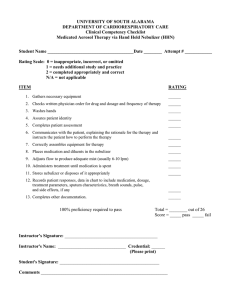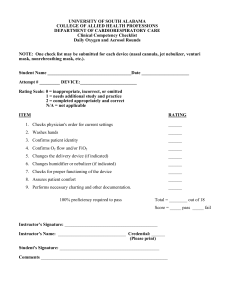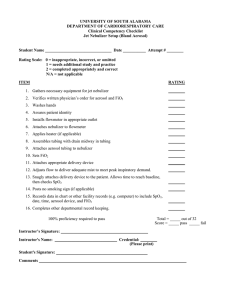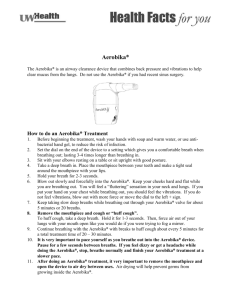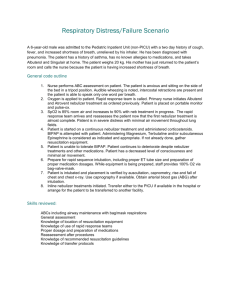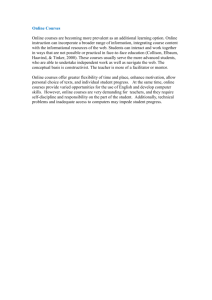LOVELACE RESPIRATORY RESEARCH INSTITUTE
advertisement
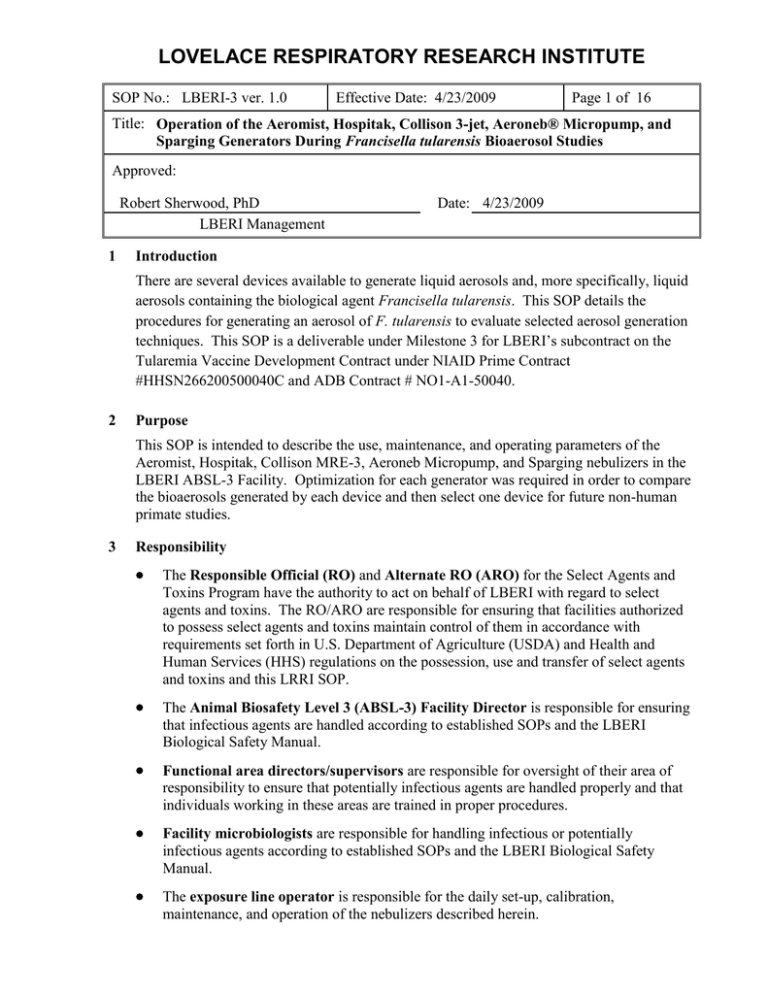
LOVELACE RESPIRATORY RESEARCH INSTITUTE SOP No.: LBERI-3 ver. 1.0 Effective Date: 4/23/2009 Page 1 of 16 Title: Operation of the Aeromist, Hospitak, Collison 3-jet, Aeroneb® Micropump, and Sparging Generators During Francisella tularensis Bioaerosol Studies Approved: Robert Sherwood, PhD LBERI Management 1 Date: 4/23/2009 Introduction There are several devices available to generate liquid aerosols and, more specifically, liquid aerosols containing the biological agent Francisella tularensis. This SOP details the procedures for generating an aerosol of F. tularensis to evaluate selected aerosol generation techniques. This SOP is a deliverable under Milestone 3 for LBERI’s subcontract on the Tularemia Vaccine Development Contract under NIAID Prime Contract #HHSN266200500040C and ADB Contract # NO1-A1-50040. 2 Purpose This SOP is intended to describe the use, maintenance, and operating parameters of the Aeromist, Hospitak, Collison MRE-3, Aeroneb Micropump, and Sparging nebulizers in the LBERI ABSL-3 Facility. Optimization for each generator was required in order to compare the bioaerosols generated by each device and then select one device for future non-human primate studies. 3 Responsibility The Responsible Official (RO) and Alternate RO (ARO) for the Select Agents and Toxins Program have the authority to act on behalf of LBERI with regard to select agents and toxins. The RO/ARO are responsible for ensuring that facilities authorized to possess select agents and toxins maintain control of them in accordance with requirements set forth in U.S. Department of Agriculture (USDA) and Health and Human Services (HHS) regulations on the possession, use and transfer of select agents and toxins and this LRRI SOP. The Animal Biosafety Level 3 (ABSL-3) Facility Director is responsible for ensuring that infectious agents are handled according to established SOPs and the LBERI Biological Safety Manual. Functional area directors/supervisors are responsible for oversight of their area of responsibility to ensure that potentially infectious agents are handled properly and that individuals working in these areas are trained in proper procedures. Facility microbiologists are responsible for handling infectious or potentially infectious agents according to established SOPs and the LBERI Biological Safety Manual. The exposure line operator is responsible for the daily set-up, calibration, maintenance, and operation of the nebulizers described herein. SOP No.: LBERI-3 ver. 1.0 Page 2 of 16 Title: Operation of the Aeromist, Hospitak, Collison 3-jet, Aeroneb® Micropump, and Sparging Generators During Francisella tularensis Bioaerosol Studies 4 Bioaerosol technicians are responsible for maintaining data generated using the procedures described herein. The ABSL-3 Bioaerosol Laboratory Supervisor is responsible for reviewing data generated under the procedures described herein. Scope This SOP describes the basic operation of five nebulizers for F. tularensis bioaerosol studies using the LBERI ABSL-3 Facility exposure system. Inter-institute variability may exist, thereby necessitating modifications to the procedures described herein. This SOP may be used in the ABSL-3 Bioaerosol Laboratories (Bldg 9223, Rooms 1027 and 1028). 5 6 Precautions Because of the inherent hazard to personnel resulting from handling highly infectious microbial agents in the ABSL-3 Facility, individuals handling agents shall wear all required personnel protective equipment (PPE), meet all occupational medicine requirements, and handle agents in a manner that minimizes the potential for inadvertent infection or contamination. PPE specific to the ABSL-3 Facility includes a powered air purifying respiratory with associated hood, nitrile and latex gloves, Tyvek coveralls, safety shoes and shoe covers. Bioaerosol generation devices are operated under high pressures. Operators shall be aware of this parameter at all times during testing. The Collison and Sparging generators are glass instruments. Users shall take extreme caution to avoid glass breakage and potential ensuing injury under ABSL-3 conditions. Materials Class II biological safety cabinet (BSC) Class III BSC Generator suspension (F. tularensis) Collison 3-jet Nebulizer (BGI, Inc.) Nebulizer top MRE-3 jet manifold Collection jar (in the case of nebulizing a material that is in abundant supply) Precious Fluids Bottle (in the case of nebulizing a material that is in limited supply) Aeromist Nebulizer (Allied Healthcare Products, Inc.) Micropump AeroNeb® Nebulizer (Aerogen, Inc.) SOP No.: LBERI-3 ver. 1.0 Page 3 of 16 Title: Operation of the Aeromist, Hospitak, Collison 3-jet, Aeroneb® Micropump, and Sparging Generators During Francisella tularensis Bioaerosol Studies 7 Sparging Nebulizer (CH Technologies, Inc.) HospitakTM Nebulizer (Unomedical, a/s) House compressed air supply with in-line pressure 0-60 psig gauge Volumetric airflow meter Flexible, conductive rubber tubing, ¼” O.D. Procedures for use of a Collison MRE-3 Nebulizer The Collison MRE-3 Nebulizer (Figure 1) is a compressed air jet nebulizer that has been the standard in bioaerosol generation for over 50 years. Though numerous configurations of the nebulizer exist, one has been optimized for F. tularensis bioaerosols at LBERI: a 3-jet version incorporating a plastic precious fluids reservoir jar. Figure 1. The Collison MRE-3 Nebulizer 7.1 Set Up Note and record the Collison nebulizer top and jet identification numbers. These numbers should be scribed on the nebulizer/jet upon initial receipt. The numbering system is sequential, beginning with 01. Attach the reservoir jar to the bottom of the nebulizer top. Connect the compressed air line to the inlet port of the nebulizer. Ensure that the compressed air line is securely fastened. This will prevent air leaks which otherwise diminish nebulization efficiency. 7.2 Calibration Using flexible tubing, connect the nebulizer output to the volumetric airflow meter. Apply in-house supplied compressed air to the nebulizer, measure the air pressure with a pressure gauge, and note the airflow output. Record the airflow output and corresponding pressure according to LRRI SOP ASE-1301. SOP No.: LBERI-3 ver. 1.0 Page 4 of 16 Title: Operation of the Aeromist, Hospitak, Collison 3-jet, Aeroneb® Micropump, and Sparging Generators During Francisella tularensis Bioaerosol Studies 7.3 Adjust the compressed air until the target output flow of the generator is achieved (7.5 ± 0.1 L/min). See Appendix A for a table of approximate airflows at various air pressures. Operation Affix the Collison nebulizer to the test system using an appropriate compression fitting. Use a Teflon® ferrel with Swagelock® fitting to prevent the ferrel from seizing to the Collison outlet port. Within the biosafety cabinet, remove the reservoir jar from the nebulizer top and aseptically dispense 8-10 mL of F. tularensis generator suspension into the reservoir using sterile, serological pipettes. The liquid level in the reservoir jar should be approximately half way between the bottom of the jet manifold and the jet orifices (approximately ⅜″ below the jet orifices). Reattach the reservoir jar to the nebulizer top. Follow all parameters as detailed in the study protocol or study specific procedures for operation of the nebulizer during bioaerosol generation. Additional tasks should include the following: Monitor and adjust the relative humidity. To control the dilution humidifier, input the appropriate settings under “Duty cycle” and “Cycle time” in LabVIEW. (e.g. Duty cycle: 90%, Cycle time: 10.0s). For F. tularensis bioaerosols, relative humidity should be maintained at 60-90%. 1. Monitor the chamber temperature. For F. tularensis bioaerosols, the accepted operating range is 20-25°C. 2. Monitor the exposure atmosphere % oxygen content. For all bioaerosols conducted at LBERI, the accepted exposure atmosphere must have an oxygen content >18%. 3. Monitor and adjust the differential pressure of the exposure chamber. For all bioaerosols conducted at LBERI, the accepted operating range is -3 to -0.05 inches of water. 4. Ensure that the nebulizer and impinger are functioning properly at exposure start-up and throughout the exposure period. Both should exhibit turbulence in the solution which is an indication of air flow. 5. Collect a prescribed particle size sample. The Collison 3-jet nebulizer generates particles with a mean mass aerodynamic diameter of 1-2 m. 6. Measure real-time dust monitor data to ensure an aerosol is present in the exposure chamber. The sample taken by the real-time dust monitor is diluted via compressed air to a readable range of 30-50 mg/m3. 7. Note and record the start and stop times for the nebulizer. In general, test runs are performed for 10 minutes. Upon completion of the bioaerosol run, aseptically remove the bacterial suspension from the nebulizer (again, using sterile serological pipettes) and transfer to an appropriate sterile tube for delivery to the Microbiology laboratory. Microbiology SOP No.: LBERI-3 ver. 1.0 Page 5 of 16 Title: Operation of the Aeromist, Hospitak, Collison 3-jet, Aeroneb® Micropump, and Sparging Generators During Francisella tularensis Bioaerosol Studies personnel are then responsible for ensuing analyses which are outside the scope of this SOP. 7.4 Cleaning 7.4.1 Non-ABSL-3 Cleaning Collison nebulizers that have not been under ABSL-3 conditions shall be cleaned with soapy/detergent (e.g. Extran 300 Concentrated Detergent, EMD Chemicals, Gibbstown, NJ ) water, plain warm water, and/or a solvent. This is followed by a one-minute complete emersion in purified water and placing onto a drying rack or paper towel to allow complete drying. 7.4.2 ABSL-3 Cleaning Collison nebulizers that have been used in under ABSL-3 conditions shall be cleaned as follows: Upon completion of the sprays/exposure, double bag the Collison nebulizer. Prior to bagging, disinfect the outside of each Collison nebulizer with 5% acidified bleach. Transfer the Collison nebulizer to a Class II BSC. Ensure that the Class II BSC is clean and that the fans are running. The magnehelic gauge on the outside of the unit can be inspected to verify proper flow. In the Class II BSC, have a setup ready to decontaminate the Collison nebulizer. This will consist of the following: o A spray bottle filled with 5% acidified bleach solution for rinsing out the Collison nebulizer cup. o A biohazardous liquid waste container for disposing of these rinse solutions. o A large bin filled with 5% acidified bleach solution for soaking the rinsed Collison nebulizer. o Empty autoclavable bin o Disposable latex gloves. While in the BSC, remove the Collison nebulizer from the bags, being careful not to spill the contents. Dispose of the bags in a biohazardous waste container. Rinse out the Collison cup using 5% acidified bleach by carefully pouring in the solution (10-20 mL), gently swirling, and disposing of the rinse in the liquid waste container. Upon completion of the rinse, completely immerse the Collison cup in the large bin containing the 5% acidified bleach solution. Do the same with the Collison top. Leave the Collison components in the decontamination solution bin for a minimum of 15 minutes. Do not remove the large bin from the Class II BSC. Remove your outer gloves and don a new pair. SOP No.: LBERI-3 ver. 1.0 Page 6 of 16 Title: Operation of the Aeromist, Hospitak, Collison 3-jet, Aeroneb® Micropump, and Sparging Generators During Francisella tularensis Bioaerosol Studies 8 When the decontamination period has been completed, remove the Collison nebulizer components and transfer to an empty, autoclavable bin. Spray the exterior of the bin with 5% acidified bleach prior to removing from the BSC. Fill the bin with purified water until the Collison nebulizer top and cup are completely submerged. Thoroughly rinse by allowing to soak in purified water for one minute. Remove the components from the water, and place onto a drying rack or paper towel(s). Slowly pour the rinse solution down the drain. When the Collison nebulizer components are dry, loosely wrap each piece in heavy duty aluminum foil. Place the wrapped Collison top and cup in an autoclavable bin and autoclave according to LRRI SOPs BSF-1549 and BSF 1564 Appendix F. Upon completion of the autoclave sterilization, transport the Collison components back into a designated area for storage. DO NOT remove the aluminum foil at this time; the pieces shall remain wrapped until needed to maintain sterilization. Procedures for use of an Aeromist Nebulizer The Aeromist Nebulizer (Figure 2) is a compressed air jet nebulizer that has been typically used in the medical industry for drug delivery. The plastic nebulizer incorporates one aerosol jet and is considered a consumable item. Figure 2. The Aeromist Nebulizer 8.1 Set Up Note and record the Aeromist nebulizer identification number. These numbers should be scribed onto the nebulizer upon initial receipt. Nebulizers are selected randomly and numbered sequentially beginning with 1. Attach the plastic reservoir jar to the bottom of the nebulizer top. Connect the compressed air line to the inlet port of the nebulizer. Ensure that the compressed air line is securely fastened. This will prevent air leaks which otherwise diminish nebulization efficiency. 8.2 Calibration Using flexible tubing, connect the nebulizer output to the volumetric airflow meter. SOP No.: LBERI-3 ver. 1.0 Page 7 of 16 Title: Operation of the Aeromist, Hospitak, Collison 3-jet, Aeroneb® Micropump, and Sparging Generators During Francisella tularensis Bioaerosol Studies Apply compressed air to the nebulizer, measure the air pressure with a pressure gauge, and note the airflow output. Record the airflow output and corresponding pressure according to LRRI SOP ASE-1301. Adjust compressed air to 10 ± 0.1 psig. Calibration of all other parameters shall be completed at this delivered pressure. 8.3 Operation Affix the Aeromist nebulizer to the test system using a ½” PVC fitting. Remove the reservoir jar from the nebulizer top and aseptically dispense 4-6 mL of F. tularensis generator suspension into the reservoir. Reattach the reservoir jar to the nebulizer top. Follow all parameters as detailed in the study protocol or study specific procedures for operation of the nebulizer during bioaerosol generation. Additional tasks should include those described for the Collison 3-jet nebulizer (Section 7.3, third bullet). Upon completion of the bioaerosol run, aseptically remove the bacterial suspension from the nebulizer and transfer to an appropriate sterile tube for delivery to the Microbiology laboratory. Microbiology personnel are then responsible for ensuing analyses which are outside the scope of this SOP. 8.4 Cleaning 8.4.1 Non-ABSL-3 Cleaning Aeromist nebulizers are considered a consumable item. Therefore, no cleaning procedures are required. Each unit will be disposed of at the end of each day in a biohazardous materials container. 8.4.2 ABSL-3 Cleaning Aeromist nebulizers are considered a consumable item. Therefore, no cleaning procedures are required. Each unit will be disposed of appropriately in a biohazardous materials container at the end of each day 9 Procedures for use of a AeroNeb Micropump Nebulizer The AeroNeb Micropump Nebulizer (Figure 3) is a reusable, passive aerosol generator that has been optimized in the medical industry for drug delivery. The plastic nebulizer produces a low-velocity, fine droplet size aerosol without compressed air and can integrate easily into existing exposure and aerosol testing equipment. SOP No.: LBERI-3 ver. 1.0 Page 8 of 16 Title: Operation of the Aeromist, Hospitak, Collison 3-jet, Aeroneb® Micropump, and Sparging Generators During Francisella tularensis Bioaerosol Studies Figure 3. The AeroNeb Micropump Nebulizer 9.1 Set Up Note and record the AeroNeb Micropump nebulizer identification number. These numbers should be scribed onto the nebulizer upon initial receipt. Nebulizers are selected randomly and numbered sequentially beginning with 1. Connect the compressed air line to the inlet port of the nebulizer. Ensure that the compressed air line is securely fastened. This will prevent air leaks which diminish nebulization efficiency. 9.2 Calibration 9.3 The AeroNeb Micropump nebulizer is a passive aerosol generator (i.e., it incorporates fogging technology). During bioaerosol generation, the output from the nebulizer is entrained with a dilution air supply. Pressure calibration of the nebulizer is therefore not necessary. Operation Affix the AeroNeb Micropump nebulizer to the test system using a ½” PVC fitting. Remove the nebulizer top and aseptically dispense 8-10 mL of F. tularensis generator suspension into the reservoir. Reattach the nebulizer top. Follow all parameters as detailed in the study protocol or study specific procedures for operation of the nebulizer during bioaerosol generation. Additional tasks should include those described above for the Collison 3-jet nebulizer (Section 7.3, third bullet). Upon completion of the bioaerosol run, aseptically remove the bacterial suspension from the nebulizer and transfer to an appropriate sterile tube for delivery to the Microbiology laboratory. Microbiology personnel are then responsible for ensuing analyses which are outside the scope of this SOP. SOP No.: LBERI-3 ver. 1.0 Page 9 of 16 Title: Operation of the Aeromist, Hospitak, Collison 3-jet, Aeroneb® Micropump, and Sparging Generators During Francisella tularensis Bioaerosol Studies 9.4 Cleaning 9.4.1 Non-ABSL-3 Cleaning AeroNeb Micropump nebulizers that have not been under ABSL-3 conditions shall be cleaned with soapy/detergent (e.g., Extran 300 Concentrated Detergent, EMD Chemicals, Gibbstown, NJ ) water, plain warm water, and/or a solvent. Consult the Material Safety and Data Sheet, if available, to determine the best method for removing the test material from the nebulizer top and the reservoir/cup. This is followed by a one minute complete emersion in purified water and placing onto a drying rack or paper towel to allow complete drying. ABSL-3 Cleaning AeroNeb Micropump nebulizers that have been used under ABSL-3 conditions shall be cleaned by first rinsing the unit with 5% acidified bleach. Following the initial rinse, submerge the unit in 5% acidified bleach for a minimum of 15 minutes. Upon completion of this step, submerge the unit in purified water to thoroughly rinse all bleach residues. Place the unit onto a drying rack or paper towel to allow complete drying. 10 Procedures for use of a Sparging Generator The Sparging Generator (Figure 4) can be considered a modified Collison nebulizer that produces aerosols by sparging air into a liquid film. During operation, the aerosolization air flow is delivered under pressure to the underside of the porous disk via a separate airtight channel. The air is then forced by pressure upwards through the pores of the disk into a liquid (here, a F. tularensis suspension). The multiple air streams emanating from the porous disk break the suspension film into bubbles within which particles are contained. An expanding pressure gradient between the inside and outside of the bubbles causes them to burst, aerosolizing the particles. Provided air streams contribute to the drying of the airborne particles and liquid filaments, thereby carrying the resulting particles and liquid residues throughout the exposure system. Figure 4. The Sparging Generator SOP No.: LBERI-3 ver. 1.0 Page 10 of 16 Title: Operation of the Aeromist, Hospitak, Collison 3-jet, Aeroneb® Micropump, and Sparging Generators During Francisella tularensis Bioaerosol Studies 10.1 Set Up Note and record the Sparging generator top identification numbers. These numbers should be scribed on the nebulizer upon initial receipt. The numbering system is sequential, beginning with 01. Connect the Sparging generator to the test system using an appropriate compression fitting. Use a Teflon® ferrel with Swagelock® fitting to prevent the ferrel from seizing to the Sparging outlet port. Attach the house carrier air line to the aerosolization inlet tube of the Sparging generator. Connect the tubing from the syringe pump to the Sparging liquid delivery inlet tube. While working in a biosafety cabinet, aseptically load the 20 mL syringe with 10-15 mL of F. tularensis suspension. The bacterial suspension will be delivered to the generator via a syringe pump connected to the system. 10.2 Calibration Using sterile, flexible, conductive tubing, connect the nebulizer output to the volumetric airflow meter. Apply compressed air to the nebulizer, measure the air pressure with a pressure gauge, and note the airflow output (8.0 ± 0.1 L/min). Record the airflow output and corresponding pressure according to LRRI SOP ASE-1301. Place the loaded 20 mL syringe into the syringe pump and power on the instrument. Adjust the syringe pump to a liquid delivery rate between 0.17 and 2 mL/min. Note that the bacterial suspension travels downward through the liquid delivery tube and is dropped onto a 1-inch porous stainless-steel disk (approximately 1 cm below the tube outlet) where it forms a thin liquid film. The aerosol will then be generated as described above. Adjust the compressed air until formation of large bubbles (approximately 1/8” to 1/2” in diameter) is observed in the air or on the surface of the porous stainless steel disk. Follow all parameters as detailed in the study protocol or study specific procedures for operation of the nebulizer during bioaerosol generation. Additional tasks should include those described above for the Collison 3-jet nebulizer (Section 7.3, third bullet). Upon completion of the bioaerosol run, aseptically remove the bacterial suspension from the nebulizer and transfer to an appropriate sterile tube for delivery to the Microbiology laboratory. Microbiology personnel are then responsible for ensuing analyses which are outside the scope of this SOP. SOP No.: LBERI-3 ver. 1.0 Page 11 of 16 Title: Operation of the Aeromist, Hospitak, Collison 3-jet, Aeroneb® Micropump, and Sparging Generators During Francisella tularensis Bioaerosol Studies 10.3 Cleaning 10.3.1 Non-ABSL-3 Cleaning Sparging generators that have not been under ABSL-3 conditions shall be cleaned with soapy/detergent(e.g. Extran 300 Concentrated Detergent, EMD Chemicals, Gibbstown, NJ ) water, Consult the Material Safety and Data Sheet, if available, to determine the best method for removing the test material from the nebulizer top and the reservoir/cup. This is followed by a one minute complete emersion in purified water and placing onto a drying rack or paper towel to allow complete drying. ABSL-3 Cleaning Sparging generators that have been used in under ABSL-3 conditions shall be cleaned as described previously for the Collison nebulizer. SOP No.: LBERI-3 ver. 1.0 Page 12 of 16 Title: Operation of the Aeromist, Hospitak, Collison 3-jet, Aeroneb® Micropump, and Sparging Generators During Francisella tularensis Bioaerosol Studies 11 Procedures for use of a Hospitak Nebulizer The Hospitak Nebulizer (Figure 5) is a compressed air jet nebulizer that has been typically used in the medical industry for drug delivery. The plastic nebulizer incorporates one aerosol jet and, like the Aeromist Nebulizer, is considered a consumable item. Figure 5. The Hospitak Nebulizer 11.1 Set Up Note and record the Hospitak nebulizer identification number. This number should be scribed on the unit upon initial receipt. Nebulizers are selected randomly and numbered sequentially beginning with 1. Attach the reservoir jar to the bottom of the nebulizer top. Connect the compressed air line to the inlet port of the nebulizer. Ensure that the compressed air line is securely fastened. This will prevent air leaks which otherwise diminish nebulization efficiency. 11.2 Calibration Using sterile, flexible tubing, connect the nebulizer output to the volumetric airflow meter. Apply compressed air to the nebulizer, measure the air pressure with a pressure gauge, and note the airflow output. Record the airflow output and corresponding pressure according to LRRI SOP ASE-1301. Adjust compressed air to 10 ± 0.1 psig.. 11.3 Operation Affix the Hospitak nebulizer to the test system using an appropriate fitting. Remove the reservoir jar from the nebulizer top and aseptically dispense 10-15 mL of F. tularensis generator suspension into the reservoir. Reattach the reservoir jar to the nebulizer top. SOP No.: LBERI-3 ver. 1.0 Page 13 of 16 Title: Operation of the Aeromist, Hospitak, Collison 3-jet, Aeroneb® Micropump, and Sparging Generators During Francisella tularensis Bioaerosol Studies Follow all parameters as detailed in the study protocol or study specific procedures for operation of the nebulizer during bioaerosol generation. Additional tasks should include those described above for the Collison 3-jet nebulizer (Section 7.3, third bullet). Upon completion of the bioaerosol run, aseptically remove the bacterial suspension from the nebulizer and transfer to an appropriate sterile tube for delivery to the Microbiology laboratory. Microbiology personnel are then responsible for ensuing analyses which are outside the scope of this SOP. 11.4 Cleaning 11.4.1 Non-ABSL-3 Cleaning Hospitak nebulizers are considered a consumable item. Therefore, no cleaning procedures are required. Each unit will be disposed of at the end of each day in a biohazardous materials container. 11.4.2 ABSL-3 Cleaning Hospitak nebulizers are considered a consumable item. Therefore, no cleaning procedures are required. Each unit will be disposed of appropriately in a biohazardous materials container at the end of each day. 12 Quality Control Compressed air is measured at the delivery point to the nebulizer with NIST-traceable pressure gauge. The operator ensures that the reading is within the operating parameters for the specific nebulizer under test. The sterilization of the system components is conducted after each test day using the ABSL3 Vernitron autoclave following procedures detailed in LRRI SOPs BSF-1549 and BSF-1564 Appendix F. 13 References 1. LRRI SOP ASE-1301, Use, Calibration, and Maintenance of Bios DryCal Flow Calibrators 2. LRRI SOP ASP-1790, Use, Maintenance, and Operation of the Collison MRE-3 Nebulizer 3. LRRI SOP BSF-1549, Operation, Maintenance, and Performance Verification of the Vernitron Micro II Medium Bulk Vacuum Sterilizer 4. LRRI SOP BSF-1564, Operation of the Nonhuman Primate ABSL-3 Exposure System 5. LRRI SOP BSF-1640, Class II Biosafety Cabinet Use in the Animal Biosafety Level 3 Facility SOP No.: LBERI-3 ver. 1.0 Page 14 of 16 Title: Operation of the Aeromist, Hospitak, Collison 3-jet, Aeroneb® Micropump, and Sparging Generators During Francisella tularensis Bioaerosol Studies 14 Calculations and Formulas Not applicable 15 Glossary ABSL-3 – animal biosafety level 3 laboratory BSC – biosafety cabinet L/min – liters per minute mg/m3 – milligrams per cubic meter mL – milliliter µm- micron PPE – personal protective equipment SOP – standard operating procedure 16 Appendices A. Collison MRE-3 Nebulizer Airflow Output Chart B. Example Nebulizer Calibration Form SOP No.: LBERI-3 ver. 1.0 Page 15 of 16 Title: Operation of the Aeromist, Hospitak, Collison 3-jet, Aeroneb® Micropump, and Sparging Generators During Francisella tularensis Bioaerosol Studies Appendix A Collison MRE-3 Nebulizer Airflow Output Chart Pressure (psig) Airflow (L/min) 20 6.0 40 10.0 60 13.5 80 17.3 100 21.0 SOP No.: LBERI-3 ver. 1.0 Page 16 of 16 Title: Operation of the Aeromist, Hospitak, Collison 3-jet, Aeroneb® Micropump, and Sparging Generators During Francisella tularensis Bioaerosol Studies Appendix B Impinger and Aerosol Generator Calibration Data Protocol No.________________________ Date:_____________________________ Calibration performed by:__________________________________________________ Impinger Calibration Impinger I.D. no. Calibration Flowrate, L/min Control Voltage, VDC Aerosol Generator Calibration [Generator ID no.______________] Control Voltage, VDC Calibration Flowrate, L/min Gauge Pressure, psig Flowrates measured using a Bios Flowmeter Serial no. = ________________________
